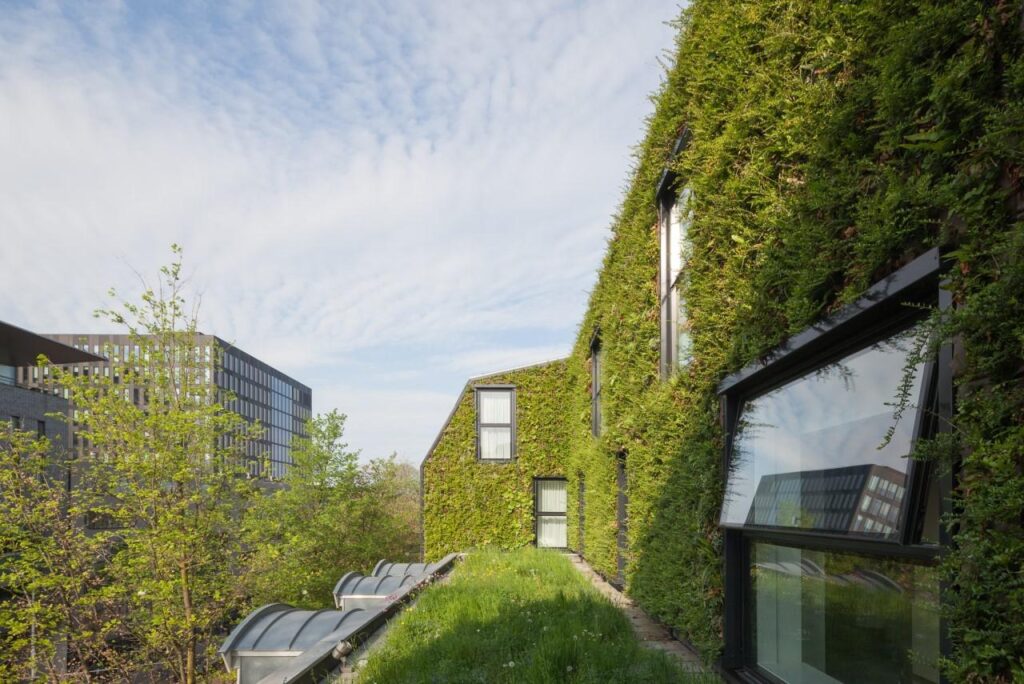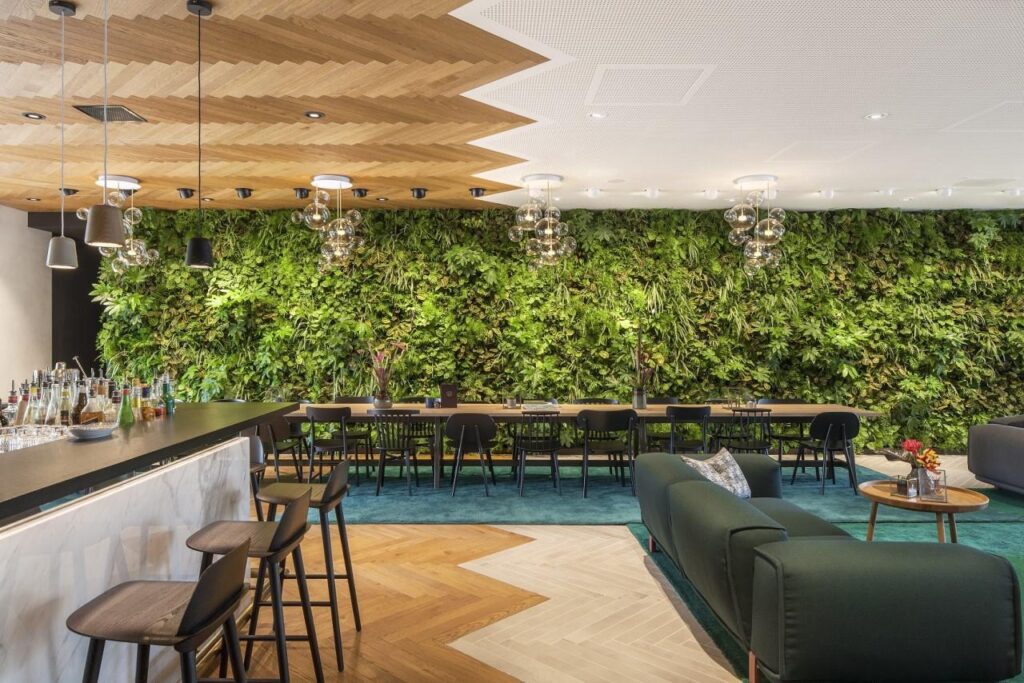


An investment that easily pays for itself
The urban landscape is changing. More and more buildings are going green, including hotels. And not without cause: studies in environmental psychology have shown that people prefer natural over non-natural/built environments. Travelers will therefore more often make a choice in favor of a hotel with a natural appearance. Other studies and surveys have also shown that hotel guests have a positive perception of hotels that take green measures and that they are willing to pay more for a stay at a green hotel.
Especially in the hospitality industry, green roofs are becoming increasingly popular in sustainable building design, due to the numerous benefits they offer. A green roof, also known as a living roof, is a vegetative layer that is planted over a waterproofing membrane on top of a building’s roof. These benefits include improved energy efficiency, enhanced aesthetics, improved guest experience and noise reduction.
Improved Aesthetics & Guest Experience
One of the most obvious benefits of green roofs is that they can support the integration of a countryside building’s design in the surrounding grounds, making it appear as part of the natural landscape. They can also transform a dull, urban gray roof into a lush, green space that is visually appealing and attractive to guests. This can be especially important for hotels and resorts, where guests are looking for a luxurious and relaxing experience. Green roofs can create a peaceful and calming atmosphere, which can be a major selling point for many hospitality businesses.
They can provide a unique and immersive experience for guests, allowing them to connect with nature and enjoy a sense of tranquility and relaxation that can be hard to find in urban areas.
Green roofs in hospitality are often designed as public spaces, with amenities such as seating areas and walking paths. They are essentially rooftop gardens that guests can explore and enjoy, adding an extra dimension to the lodging ambiance, and offering them a range of unique activities and sustainable amenities they can enjoy without even having to leave the hotel’s premises, such as yoga classes, rooftop bars, or even farming activities. This can help differentiate a hotel from its competitors, and create a memorable and engaging experience for its guests.
Energy Efficiency
An important advantage of green roofs is that they can make roof surfaces cooler. The building’s energy consumption is reduced by the provided insulation of. the layers of vegetation and soil, that help regulate the temperature of the building, and reduce the need for heating and cooling. This can result in notable energy savings, a significant benefit for both the environment and the building’s bottom line.
Noise Reduction
Green roofs can also help reduce noise pollution. The plants and soil act as a natural sound barrier, which can absorb ambient noise and deflect the noise from nearby roads, buildings, or other sources. This can be particularly important for hospitality projects located in noisy areas or near busy roads. They are an attractive option for building and hotel owners who want to incorporate sustainable design and make a positive impact on the environment.
European hotels with green roofs
1. Hyatt Regency Hotel ***** | Amsterdam, The Netherlands
In the ‘Plantage’ area in Amsterdam you can find this sustainable and environmentally friendly 5-star hotel. In 2017, the Hyatt Regency Hotel Amsterdam received the highest BREAAM-score ever given to a hotel in the Netherlands. This proves that the hotel does justice to its three values: green, sustainability and well-being. They are also visible in its living walls, located inside as well as outside of the building. The bee- and butterfly-friendly green roof adorning the building gives a boost to the local biodiversity. Are you visiting the Dutch capital? Then don’t forget to include a stay at the Hyatt Regency Hotel Amsterdam!
Green facade, a green roof and a living wall at the Hyatt Regency Hotel in Amsterdam
2. Radisson Blu Hotel **** | Sopot, Poland
The new Radisson Blu Hotel in Sopot, Poland, is located just 250 meters from the wide sandy beach along the Baltic coast. The hotel has 219 rooms, 2,000 m² of conference space, and a spa & wellness center for guests to unwind. The rolling dune landscape that surrounds the hotel is also reflected in its design. Thanks to the vegetation blankets that have been installed on the undulating roof, the hotel blends in seamlessly with its characteristic environment. The green roof is not only beautiful, it is also provides an excellent ecological solution for the collection of rainwater and the stimulation of the local biodiversity.
Photo credits: Radisson Blu Hotel Sopot
3. Hotel Gilbert **** | Vienna, Austria
Whilst visiting Vienna, a sustainable and modern building might catch your eye amidst the classic Viennese buildings. It won’t come as a surprise that this attractive establishment is number one among Vienna’s top eco-hotels. Hotel Gilbert has only recently opened its doors, but the building’s history can still be felt, as the original layout has been preserved. Completely in line with the current zeitgeist, the adjacent restaurant uses flowers, herbs and vegetables grown on their private roof terrace. Together with its location near the popular Museum Quarter, it makes this location the perfect meeting place for new inspiration.
4. Hotel Mitland **** | Utrecht, The Netherlands
This hotel, situated in the heart of the Netherlands, is a true eco-friendly hotel and has been in the possession of the Golden Green Key certificate since 2012. The Green Key is an international Eco label for the tourism industry. Hotel Mitland sports a vast Sedum-Herb roof and is equipped with a special swill-pit for organic waste. It even has its own cogeneration (CHP) plant to reduce CO2 emissions. In addition, the nature-inclusive hotel provides two charging points for electric cars. If you decide to visit Utrecht and surroundings, choose Hotel Mitland for a real green experience!
5. Hôtel Mercure Nantes Centre Gare**** | Nantes, France
A green place to stay in the French city of Nantes, is the Mercure Hotel. Since 2020, the hotel has been equipped with a beautifully decorated green facade that can be seen from afar. This unique beacon provides a piece of green appearance in a mainly urban environment. When going sightseeing in the 6th largest city in France, don’t forget to visit its beautiful historic castle, cathedrals, the Loire River and the city’s lush gardens. After which you can reminisce about them, while enjoying the green ambiance of the hotel’s striking Semper Green wall.
6. Duinhotel Breezand **** | Vrouwenpolder, The Netherlands
Nature and sustainability are the two central design themes of the Breezand Duin hotel (Dune Hotel), which is part of the Breezand holiday park. The main building sports solar panels and seasonal thermal energy storage. The future-proof hotel has green roofs on several floors, supplemented by various types of grass, making it possible for the hotel to blend into the dune landscape. These beautiful roof gardens are not only nice on the eyes, but also offer a cooling effect and many other advantages, like water storage, sound insulation and the promotion of biodiversity. Fancy a green beach holiday in the Netherlands? Book your overnight stay at Duin hotel Breezand!
7. Hampton by Hilton Alcobendas *** | Madrid, Spain
This comfortable hotel, situated in the north of Madrid, is the perfect place to stay while on business, sightseeing or en route to another destination. The heart of the hotel is a seasonal swimming pool on the roof terrace, surrounded by an undulating Sedum roof, that adds a splash of color to the modern building. The hotel is a short walk to the European University of Madrid, only five minutes from plenty of shopping and dining opportunities, as well as the National Museum of Science and Technology.